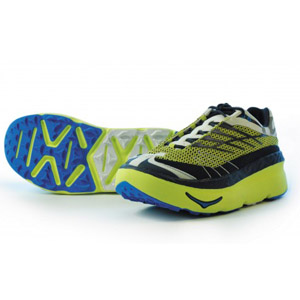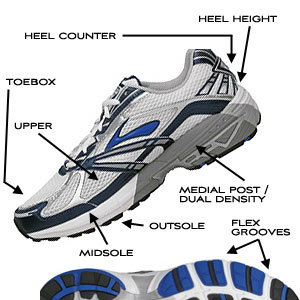The Great Running Debate

I received an article last week from our learned and able footwear editor Jeroen Van Geelen. He wrote: "New Balance partners with Good Form Running and translates that into a collection of more minimalist shoes."
I immediately called Good Form Running and spent an hour on the phone with its founder—also a founder/owner of the popular running mega-store Playmakers in Michigan—Curt Munson. What I read on Good Form Running is eminently logical and—if I might recast into my own terms—reads: run proud; don't overstride; strike at the midfoot; maintain a proper cadence (180 steps/minute).
Still, I was at a loss to understand how this translates to an endorsement of "minimalist" shoes. I was sure Jeroen had unearthed a wisdom on equipment from a technique primer that did not, in fact, grant such a teaching.
But, by golly, Jeroen had it right. Curt confirmed that Good Running Form's wisdom and advice, when followed, has as an "output" choosing more "natural" or "barefoot" or "minimal" style footwear.
I then called a few folks who manage other trend setting technical running stores, and their view in the aggregate is that stalwarts like Brooks and Asics are slow to adapt to the natural or barefoot running movement (as represented in the products they make) while New Balance and some others appear more nimble in their response to this trend in footwear manufacture and technology.
This lays out the landscape for a debate I'd like to see us have—and that we will have, both in the articles we write and on our reader forum—throughout the first half of this year.
While Curt Munson and I agree almost entirely on what constitutes good running form, where I'm not convinced is in Curt's equipment imperatives—with which New Balance seems to agree—that flow from good running technique. (New Balance did not return my call in time for this article, but has since reached out with a response.)
If I use a cash versus and accrual form of accounting, this doesn't make me more likely to be a Baptist than a Zoroastrian. To me, the connection between good running technique and natural/minimalist shoes is almost that tenuous.
Let me qualify "almost." It's certainly true that an overstriding, heel striking, overpronator will land with just that much more force, flattening out his high arch, rolling over to the medial side in a more pronounced way. So, he'll need that much more support to prop up his bone structure. Hence the "need" for motion control shoes that look and feel—and weigh—more like aircraft carriers than articles of footwear.
However, the tone and posture of the debate isn't geared toward moving from a "motion control" shoe to a sprightlier shoe one might find in the guidance or stability categories. Rather, it's a move all the way to Vibram Five Fingers or, maybe, a cushy neutral racer or lightweight trainer void of all medial support.
It's not that I'm entirely on the side of Asics—a company that has driven trends that I question and have questioned for a generation. Finally barefoot advocates like Chris McDougall (Born to Run) have gotten the attention of Asics and Brooks so we can get answers to these questions. My fear is that the cure may be worse than the disease, if a generation of runners and triathletes who do legitimately need medial support, or perhaps cushioning due to the repetitive stress from an asphalt road Tarahumara Indians don't face.
Speaking of Tarahumaras, McDougall's book has had the further effect of fostering a faux-truth that leverages the good in Born to Run well past its usefulness (I'm not blaming McDougall for this). I keep hearing, from people in our industry and who should know better, about the lessons we can learn from the East Africans and Tarahumara Indians. And the "we" who should learn these lessons are you and me (rather than just the lightweight, fleet of foot, elite American runners).
As an example, I ran across a website touting the ingestion of pinole and chia during runs. "I'm sure you know all about how high-tech running shoes have increased the incidence of injury, not reduced it," explains the site's author. "Well, it’s sort of the same way with commercial sports drinks and energy gels."
In other words, now that we're running in shoes like the Tarahumara, let's also eat like the Tarahumara.
Contemporaneous accounts between West Coast native Americans and early Western contacts confirm that European digestive tracts entirely and wholly rejected the native staple food of acorn mush. Perhaps we might choose an alternative food source, such as that indispensable to Miwok natives who lived where Deena Kastor and Meb Keflezhigi now live and train: fly larvae scooped off the bottom of Mono Lake.
Could we could turn this into an energy gel?
What many European stomachs can digest is bovine milk, because, over a period of only a very few thousand years natural selection favored Scandinavians able to generate lactase. Does this mean that if a Tarahumara wanted to run as fast as Lasse Viren he should start drinking milk?
I'm concerned when triathletes read this false stipulation that modern footwear technology causes, rather than prevents, injury. I have seen no compelling evidence supporting this view. What I do know is that there are a lot more runners, and a lot more triathletes, than there used to be a generation or two ago—perhaps an order of magnitude more in the case of triathlon. The adoption of a sport by those who aren't naturally or physically inclined to it is good—but it also means these later adopters need to be treated with greater care and expertise, and they often aren't. Hence an expected increase in injury.
I'm bully for investigating conventional wisdom about trends in technical running footwear. But we ought to drill this topic down into its constituent parts. Here's an example: Look at the Hoka One One, a new shoe getting rave reviews from ultra-distance trail runners. The people who love this shoe (pictured at the top) invariably love Vibram Five Fingers as well. This is what I've heard, at least, from the trusted specialty retail veterans to whom I've spoken. Obviously, you can't find two shoes more disparate in their "Y" axis. My question is, then, what is a natural, or barefoot, or minimalist, shoe? What is the shoe that good running form readies you for? What are its characteristics? It's been my experience that natural running adherents have a hard time answering that question, and certainly do not, as a group, form a common answer.
Curt Munson is a compelling and experienced technical footwear professional, and I look forward to learning from him. It seems to me that companies like Brooks and—especially—Asics have seen the narrative about sound running technology taken away by those espousing a new and novel approach. To be sure, Curt sells more Asics and Brooks in his stores than any other shoe—probably more than all the other brands put together. So, it's not as if Curt is inured to the value in these brands.
Still, there is a tension in the air as regards the right approach as the running shoe companies move forward. I think this is a good time to hash out that discussion in technical terms and, to that end, we intend to provide it in these pages.
But, look, I'm not going to play the curmudgeon. While I currently run in the "old technology" represented by my trusty Brooks Adrenalines, I have a pair of Hoka One Ones winging to me as I write this, and I'm very much looking forward to giving them a try.



Start the discussion at slowtwitch.northend.network